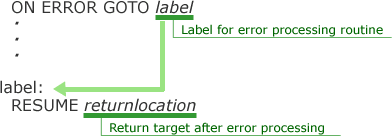Use error trapping to process run-time errors in programs.

Run-time errors frequently accompany communications and other operations even during normal use, so such user application programs should use error trapping to provide their own built-in recovery processing.
The ON ERROR GOTO statement specifies a label giving the starting point for this processing whenever there is a run-time error. Alternatively, specifying 0 disables error trapping.
Returnlocation specifies how the recovery processing returns the program to normal processing. (See Table.)
| Setting | Return target after error processing |
|---|---|
| Blank | Statement triggering run-time error |
| 0 | Statement triggering run-time error |
| NEXT | Statement following one triggering run-time error |
| Other label | Line specified by the label |
The ERR and ERL functions provide additional information about the run-time error and its location. The error processing routine can branch on the error type, for example.
Retry if a file transfer encounters an error
private tempkey$ ' declare variable open "COM1:115200" as #1 ' open communications device file out &h6060, 3 on error goto ERRCOM ' branch to ERRCOM on communications errors xfile "TEST1.DAT" ' Send file on error goto 0 close #1 end ERRCOM: print "Transmission error!" print "CODE:";hex$(ERR); print " ADDR:";hex$(ERL) print "Press a key to retry."; tempkey$ = input$(1) resume 0
If you have not registered
The services on this member site are available only for registered customers.